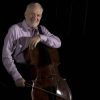- To ‘release’ your left hand before you shift.
- Why shifting with reliable accuracy requires anticipation.
- We use physical release to overcome inertia. This sensation initiates the shifting motion.
- Because the big muscles of your back and upper arm need more time to move than your hand and fingers, initiate the lift necessary to shift from your upper arm. This motion is called the anticipatory motion. This anticipatory motion is necessary in order to shift smoothly, accurately and with interpretive intent.
- With your upper arm leading, your hand and finger follow. Your upper arm lifts your hand; your hand does not lift your upper arm.
- If your shifts are quick or jerky, begin them earlier. Anticipate: a split second can make a difference. In a fast passage, feeling a shift begin several notes ahead keeps the motion fluent, giving you exact control of your arrival.
- Integrate this sequence of anticipation, release and shift into one coordinated motion. With practice, a single, fluent physical gesture connects the separate steps and is timed with the underlying pulse of the music.
- The key to shifting is timing the motion. We can shift at many different speeds for musical effect, but seldom do we need a lightning quick shift. Think, “all shifts are slow.” Make the few exceptions when needed.
- Descending shifts require an even earlier start than ascending shifts; you are pulling down against gravity. Because descending shifts often seem less risky, it’s all too easy to neglect following this shifting process.
- Consciously use your ear to tell your hand exactly when to stop. A kinesthetic sense of distance is important; make sure to develop this way of ‘knowing’ the fingerboard. But for good intonation, don’t rely entirely on your kinesthetic sense. Your ear is the final arbiter.
- Distinguish between a shift and a musical slide. Shifts can be inaudible, gentle or thick slides. The ear, guided by your musical taste and intention, decides on the sound of the shift.
- Shifts are an expressive part of music making; different types of shifts and their expressive use will be discussed in other lessons.
About

Paul Katz
Paul Katz is known for his 26-year career as cellist of the internationally acclaimed Cleveland Quartet; as a world-renown teacher…
See MoreCellosophy
"A fast shift is like driving down the street one hundred miles per hour and trying to get into a tight parking space. You might make it, but the risk is high." -Dorothy DeLay